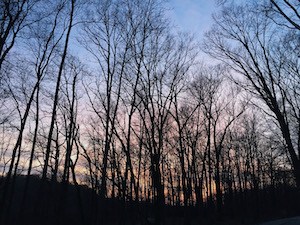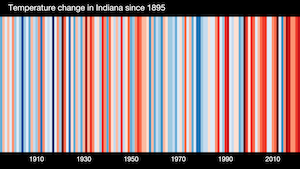by Mary Hrovat

McCormick’s Creek State Park is one of my favorite hiking spots. The creek flows through a little canyon with a waterfall in a beautiful wooded area. I’ve been visiting the park for more than 40 years. It’s a constant in my life, whether the waterfall is roaring in flood or slowed to a trickle during a dry spell or, once in a great while, frozen solid.
Late in the evening of Friday, March 31, an EF3 tornado struck the campground in the park. It caused considerable damage, and two people were killed. After the tornado left the park, it seriously damaged several homes in a rural area just outside Bloomington. It was part of an outbreak of 22 tornadoes throughout the state. A tornado that hit Sullivan, Indiana, destroyed or damaged homes and killed three people.
It was tough to see spring beginning with such serious damage and loss of life in a beloved spot. It was also sobering to see photographs of the destruction in Sullivan. It seems that I’ve seen many such images from places to the south and southwest of us this winter, and in fact 2023 has been an unusually active year for tornadoes in the U.S. so far. There have already been more tornado fatalities in 2023 than in all of 2022 nationwide.
###
Tornadoes are not uncommon in Indiana, and spring weather is typically unsettled, so the stormy weather isn’t surprising. However, it comes in the context of multiple extreme weather events worldwide. For example, California saw an incredible amount of rain and snow this winter, accompanied by flooding; there’s probably more flooding ahead when the snowpack melts. Pakistan experienced staggeringly widespread flooding in summer 2022, while parts of Europe and China saw extreme heat and drought. The U.S. West has been in an extended period of severe drought, which has been eased but not resolved even by the winter’s intense rain and snowfall. I could go on and on.
It’s difficult to attribute any single event to climate change, but the frequency and severity of extreme weather in recent decades are in line with climate predictions based on increasing temperature. So the tornadoes in late March seem a little more threatening than they would have 20 or 30 years ago, more like a sign of things to come.
###

For a long time, I thought of global warming as largely a concern for the future, and I’ve been surprised at the speed with which it’s occurring. I didn’t expect to see such an unending stream of extreme weather events already.
Bloomington’s share of the disruption seems mild compared to other events worldwide, but we’ve had some notable storms. For example, two storms in May 2011 caused straight-line wind damage, including extensive tree loss on campus and in a city park. The second of these storms also caused a tornado southwest of Bloomington. After the first storm, I took photos of debris in my yard and trees lying across walkways on campus. I thought that the amount of damage was fairly impressive, until I saw what the second storm did. That was when I learned that some trees can fan out like a deck of cards when a branch or the trunk is broken by high winds.
Overall rainfall is becoming more concentrated in single events, and so we’ve seen both drought and flooding. Summer 2012 was unusually hot and dry, with multiple days over 100°F. In a three-day stretch at the end of June and the beginning of July, daily high temperature records going back to the Dust Bowl were broken. Severe flooding occurred in June 2021, when Bloomington received a two-day total of 6.1 inches of rain. Parts of downtown were underwater, and someone driving was killed when his vehicle was swept away by flood waters.
Still, the truly catastrophic events over the past couple of decades have happened elsewhere, and I had a lingering naive sense that they would continue to happen elsewhere—coastal areas, places built on permafrost, the parched Southwest. This feeling faded with time, vanishing completely in summer 2022. Intense rainfall over short periods caused heavy flooding in St. Louis, eastern Kentucky, and eastern Illinois within a period of a couple of weeks. The St. Louis airport received 9.06 inches of rain in 15 hours, and 7.68 inches of that fell in one 6-hour period. It’s hard to imagine. Death Valley and Dallas had similarly intense rainfall events later that summer.
So I’ve started to wonder what it would be like if it was my neighborhood swept by high winds, lying in splintered ruins and sodden clumps. I wonder what prolonged drought might do to my yard, my neighborhood, my city, my state. And now I wonder what McCormick’s Creek State Park will look like the next time I see it.
###
Climate change is evident in many things besides disasters. Since I moved to Bloomington 43 years ago, Bloomington has seen increases in the average annual temperature, number of days above 95°F, and number of heavy rain events, and a decrease in the number of days with temperatures below freezing. Further changes in these directions are expected. The environmental and social effects are hard to predict.
I think our surroundings and daily lives are going to change much more than we realize, especially for people who spend much time in nature. I wonder how the natural landscape—yards and gardens as well as wilder areas—will change. I wonder what new pests we’ll see. The weird thing is that we’re not crossing climate zones, as people do when they move from one place to another. Climate zones are crossing our homes.
One of the most difficult things for me is to see the local seasons changing. Summer often extends well into what used to be fall months, postponing the cool dry days I love and sometimes affecting the duration and range of fall colors. Spring is often warmer, and winter is milder, which I find discouraging because I love cold weather and snow. These seasonal changes have made me very aware of how attached I am to the dependable round of the seasons, which varies from year to year but seemed to be bounded within some set of normal conditions.
One reason I’m bothered by the shifting of the seasons is that there’s a sense of comfort and continuity in having reliable seasonal rituals, large and small. The familiar cycle of the year reminds me that I’m part of something larger than myself that will go on after I’m gone: the natural world and the human groups to which I’m bound.
That sense of continuity and connectedness is an essential part of how I face loss and grief, including the grief I feel when I read about the effects of climate change. But it’s also part of what we’re losing to climate change and other environmental threats. This situation is testing my ability to value experience for its own sake, in the moment, and to love the perishable and fleeting. On the other hand, what else is there to do?
###
You can see more of my work at MaryHrovat.com.
